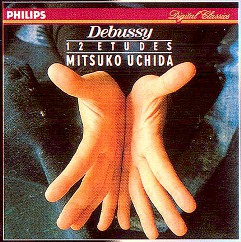Claude Debussy – 12 Etudes for Piano In 2 Books L.136 (1990)
Claude Debussy – 12 Etudes for Piano In 2 Books L.136 (1990)

1. No. 1, 'Pour les cinq doigts' (after Czerny
2. No. 2, 'Pour les tierces'
3. No. 3, 'Pour les quartes'
4. No. 4, 'Pour les sixtes'
5. No. 5, 'Pour les octaves' Listen
6. No. 6, 'Pour les huit doigts'
7. No. 7, 'Pour les degres chromatiques'
8. No. 8, 'Pour les agrements'
9. No. 9, 'Pour les notes repetees'
10. No. 10, 'Pour les sonorites opposees'
11. No. 11, 'Pour les arpeges composes' II
12. No. 12, 'Pour les accords'
Mitsuko Uchida – piano
Early in 1915, disheartened by the menace of World War I and gravely ill with cancer, Claude Debussy (1862-1918) nevertheless managed to compose. The fruits of his labors, 12 Etudes (study pieces or exercises), would be his last important works for solo piano, and would represent a distillation of the composer's musical legacy. It was appropriate for Debussy—the most original composer for the piano since Franz Liszt—to join the ranks of etude composers. Equally fitting was his dedication of his two volumes to Frederick Chopin, noting that the serious nature of the exercises was offset by a charm reminiscent of the earlier master.
The etudes are divided into two books, each different in conception. Book I is devoted to exploring the technical problems and musical possibilities inherent in different intervals (thirds, sixths, etc.), while Book II engages in the exploration of musical syntax and style. In all, the etudes are witty, challenging, and inspired. Though academic in nature—and perhaps less easily digested than other of Debussy's works—they fall closely on the heels of his popular Préludes and Images, and reflect the same aesthetic concerns: complex harmonies, fragmented melodic lines, and colorful textures.
The first etude of Book I, "Pour les 'cinq doigts'-d'apres Monsieur Czerny" (For Five Fingers-after Mr. Czerny), is inspired by the five-finger exercises of Carl Czerny. Debussy pantomimes the pedantic works by placing figurations in grotesque juxtaposition and introducing bizarre modulations. "Pour les Tierces" (For Thirds) presents an extraordinary variety of patterns in parallel thirds, excepting those already encountered in "Tièrces alternées" from the second book of Préludes. "Pour les Quartes" (For Fourths) exercises the pianists ability in parallel fourths. Almost needless to say, quartal harmony abounds, making this etude more tonally adventurous than many of the others. "Pour les Sixtes" (For Sixths) is a slow and meditative work with two fast interludes, and one forte interruption. "Pour les Octaves" (For Octaves) combines chromaticism, whole-tone harmonies and complex syncopation. Probably the most brilliant etude of both books, it is equally difficult to play. "Pour les huit doigts" (For Eight Fingers) is meant to be performed (the composer's suggestion) without the use of the thumbs, due to the division of the figuration into four-note scale patterns. It finds humor in its rigid insistence on four-note groupings and sudden ending.
Book II begins with "Pour les degrés chromatiques" (For Chromatic Intervals), an essay in the use of the chromatic scale, both compositionally and technically. "Pour les agréments" (For Ornaments) is one of the most fiendishly difficult works in the repertoire. The entire fabric of the music is created by juxtaposing musical embellishments, arpeggiations, and miniature cadenza-like passages. "Pour les notes répétées" (For Repeated Notes) requires a performer able to execute repeated tones with great rapidity while still maintaining the piece's humorous, scherzando atmosphere. One wry melodic fragment balances the otherwise relentlessly staccato texture. "Pour les sonorités opposées" (For Opposing Sonorities) emphasizes the kind of multiple-layered textures found earlier in the second set of Images and many of the préludes. "Pour les arpéges composés" (For Composed, or Written-out, Arpeggios), easily the best-known of all the etudes, redefines the arpeggio to include a variety of non-harmonic tones (such as the added second or the added ninth). "Pour les accords" (For Chords), is probably the nearest thing to a Romantic virtuoso piece that Debussy ever produced. Mammoth in conception and brutally difficult, this etude juxtaposes relentless perpetual motion with an almost uncomfortably still middle section. A truncated reprise precedes a driving conclusion that puts even the most skilled performer to a grueling test, both technically and interpretively. ---All Music Guide
download: uploaded anonfiles yandex 4shared solidfiles mediafire mega filecloudio
Last Updated (Wednesday, 23 October 2013 22:49)








